Energy and the Environment Research in Civil and Environmental Engineering
FACULTY CONTACTS:
- Dr. Jennifer Benning,
Assistant Professor
-
Dr. Venkata Gadhamshetty,
Assistant Professor
- Dr. Scott Kenner,
Professor
- Dr. Soonkie Nam,
Assistant Professor
-
Dr. James Stone,
Department Head
CAREER: Corrosion Resistance of Nano-meter Graphene Coatings in Aggressive Microbial Environment
The National Science Foundation (NSF) has awarded Professor Gadhamshetty with a prestigious CAREER award that carries a $500,000 research grant. The central goal of this project is to investigate a new class of minimally invasive (thickness of few nanometers), pin-hole-free, robust, and protective coatings made from conformal graphene for use against microbial corrosion. While there are commercial coatings available for metal protection, they fail in the aqueous and microbial environments. The annual costs for the direct and indirect effects of metallic corrosion on infrastructure have been reported to reach nearly $1 trillion in United States. Microbial corrosion accounts for 20-40 % of the total corrosion costs. This project enables the rational design of the next generation of minimally invasive, nanometer-scale, microbial-corrosion resistant coatings featuring graphene building blocks. It will focus on four broader impact objectives: 1) to develop an Adobe-director-based virtual laboratory to provide students with hands-on tutorials on microbial corrosion/Gr experiments; 2) to integrate graphene research in undergraduate curriculum; 3) to encourage under-represented American Indians (from 9 SD reservations) to join BS and MS degrees; and 4) to work with educational experts to evaluate the educational/outreach activities.
Riverbank Erosion and Stability on the Missouri River
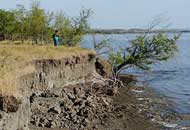 The increasing number of extreme climate events is ultimately responsible for severe river flow conditions that cause drought, flooding, and freezing. These conditions alter the hydraulic and geotechnical properties of both the river flow and riverbanks, and eventually make riverbanks more susceptible to bank erosion and mass failure. In South Dakota, sections of the Missouri River have experienced significant loss of riverbanks due to erosion and mass failure, directly affecting several local communities including a Native American tribe. A research team led by
Dr. Soonkie Nam at South Dakota Mines has teamed up with USGS researchers to experimentally and numerically investigate the riverbanks near Lower Brule, SD.
The increasing number of extreme climate events is ultimately responsible for severe river flow conditions that cause drought, flooding, and freezing. These conditions alter the hydraulic and geotechnical properties of both the river flow and riverbanks, and eventually make riverbanks more susceptible to bank erosion and mass failure. In South Dakota, sections of the Missouri River have experienced significant loss of riverbanks due to erosion and mass failure, directly affecting several local communities including a Native American tribe. A research team led by
Dr. Soonkie Nam at South Dakota Mines has teamed up with USGS researchers to experimentally and numerically investigate the riverbanks near Lower Brule, SD.
Evaluating Stormwater Contamination in Rapid City, South Dakota
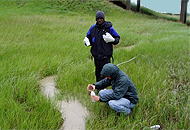 Stormwater management is an area of increasing importance to the field of engineering as global climate change increases extreme weather events and continued land development decreases permeable surface area to absorb stormwater runoff. In this research,
Dr. Scott Kenner and his team are working to solve a problem of fecal contamination in stormwater runoff in two of Rapid City's major drainage basins. The project seeks to determine the source of contamination, and then evaluate recent stormwater design criteria developed by the city to determine their effectiveness in preventing or mitigating contamination.
Stormwater management is an area of increasing importance to the field of engineering as global climate change increases extreme weather events and continued land development decreases permeable surface area to absorb stormwater runoff. In this research,
Dr. Scott Kenner and his team are working to solve a problem of fecal contamination in stormwater runoff in two of Rapid City's major drainage basins. The project seeks to determine the source of contamination, and then evaluate recent stormwater design criteria developed by the city to determine their effectiveness in preventing or mitigating contamination.
Agricultural Life Cycle Assessment Modeling
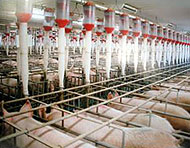 Agriculture and other industries are turning to engineers to assist them in meeting demands from the marketplace for sustainability and reduction in greenhouse gas production in their operations. With the sponsorship of several agricultural organizations,
Dr. James Stone and his colleagues at South Dakota State University are developing several life cycle assessment (LCA) models for all aspects of swine, beef, and feed (corn, soymeal, distillers’ grain) production, including feed growing and harvesting, antibiotic manufacturing, and facility operations. The research team will use these models to identify ways to increase swine production efficiencies, reduce resource consumption and negative environmental impacts, and improve the overall sustainability of these operations.
Agriculture and other industries are turning to engineers to assist them in meeting demands from the marketplace for sustainability and reduction in greenhouse gas production in their operations. With the sponsorship of several agricultural organizations,
Dr. James Stone and his colleagues at South Dakota State University are developing several life cycle assessment (LCA) models for all aspects of swine, beef, and feed (corn, soymeal, distillers’ grain) production, including feed growing and harvesting, antibiotic manufacturing, and facility operations. The research team will use these models to identify ways to increase swine production efficiencies, reduce resource consumption and negative environmental impacts, and improve the overall sustainability of these operations.
Modeling the Effect of Urbanization on Two Watersheds in Rapid City, SD
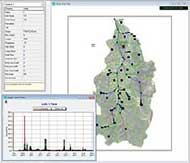 Continued urbanization has led to increased volumes of storm water runoff and decreased water quality in many previously forested or suburban watersheds. The goal of this study is to assess the impacts of increased impervious area and its connectedness on water quantity and quality in storm water runoff for two drainage basins in the Rapid Creek watershed in Rapid City, South Dakota. The results of this study emphasize that the level of connection between the impervious surfaces has a significant influence on the volume and peak flow rates occurring at the watershed outlet. This research was funded by the city of Rapid City and an USGS Cooperative Ecosystem Studies Unit agreement with South Dakota Mines. For more information, contact
Dr. Scott Kenner.
Continued urbanization has led to increased volumes of storm water runoff and decreased water quality in many previously forested or suburban watersheds. The goal of this study is to assess the impacts of increased impervious area and its connectedness on water quantity and quality in storm water runoff for two drainage basins in the Rapid Creek watershed in Rapid City, South Dakota. The results of this study emphasize that the level of connection between the impervious surfaces has a significant influence on the volume and peak flow rates occurring at the watershed outlet. This research was funded by the city of Rapid City and an USGS Cooperative Ecosystem Studies Unit agreement with South Dakota Mines. For more information, contact
Dr. Scott Kenner.
Can Electricity Be Generated from Waste at Ambient Conditions?
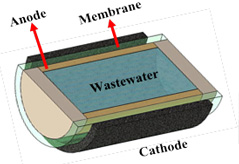 Dr. Gadhamshetty’s laboratory focuses on the development of next-generation, biological and bioelectrochemical processes for treating anthropogenic waste. This research is innovative due to its ability to extract energy and electricity from the waste matter, with simultaneous waste treatment. The technologies can be applied for recovering energy from wastewater and landfills at ambient conditions. The cutting-edge research lies at the intersection of microbiology, electrochemistry, nanomaterials, and reactor design), and provides innovative solutions to complex problems facing our environment. Current research is focused investigating the feasibility of bioelectrochemical technology to treat and polish municipal wastewater, for possible reuse as the cooling water in power plants.
Dr. Gadhamshetty’s laboratory focuses on the development of next-generation, biological and bioelectrochemical processes for treating anthropogenic waste. This research is innovative due to its ability to extract energy and electricity from the waste matter, with simultaneous waste treatment. The technologies can be applied for recovering energy from wastewater and landfills at ambient conditions. The cutting-edge research lies at the intersection of microbiology, electrochemistry, nanomaterials, and reactor design), and provides innovative solutions to complex problems facing our environment. Current research is focused investigating the feasibility of bioelectrochemical technology to treat and polish municipal wastewater, for possible reuse as the cooling water in power plants.
Particle-Mediated Enhanced Transport of Semi-Volatile Organic Compounds in the Indoor Environments
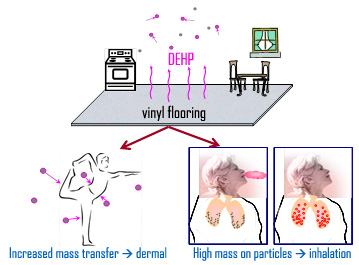 Occupants of buildings are exposed toxic chemicals from the vast number of modern building products and furnishings that continuously release these compounds. The occupants’ burden of toxic semi-volatile organic compounds (SVOC) is significantly affected by proximity to sources in indoor environments. The NSF funded collaborative research effort between South Dakota Mines, Missouri S&T, Virginia Tech and University of Sydney will carefully combine experimental quantification of relevant parameters (partition and transport phenomena) with model analysis. The results will be used to test theoretical models of particle mediated enhanced emissions and uptake. Further, experimental results and mass-transfer models will be integrated into indoor air quality models to improve predictions of exposure, dose and risk to indoor sources of SVOCs. Contact Dr.
Jennifer Benning for more information.
Occupants of buildings are exposed toxic chemicals from the vast number of modern building products and furnishings that continuously release these compounds. The occupants’ burden of toxic semi-volatile organic compounds (SVOC) is significantly affected by proximity to sources in indoor environments. The NSF funded collaborative research effort between South Dakota Mines, Missouri S&T, Virginia Tech and University of Sydney will carefully combine experimental quantification of relevant parameters (partition and transport phenomena) with model analysis. The results will be used to test theoretical models of particle mediated enhanced emissions and uptake. Further, experimental results and mass-transfer models will be integrated into indoor air quality models to improve predictions of exposure, dose and risk to indoor sources of SVOCs. Contact Dr.
Jennifer Benning for more information.
Geochemical Fate and Transport Modeling for Uranium In-situ Recovery (ISR) Mining
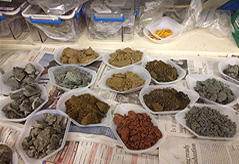 The goal of uranium ISR restoration is a return of the site to pre-operation baseline conditions, but historically, this is not always feasible. Uranium ISR sites typically exhibit varying degrees of natural attenuation potential that may influence the degree of restoration required, with reactive iron and organic carbon shown to strongly influence uranium transport and fate. Reactive transport modeling provides useful insight into the inherent restoration potential of a mined aquifer, providing stakeholders with a better understanding of potentially necessary restoration requirements. The research performed by
Dr. James Stone's research group (
http://jamesstonesdsmt.wix.com/stone) include 1-D uranium transport surface complexation modelling efforts that integrate data from batch adsorption isotherm experiments using post-mining and post-reclamation soil core samples, site upgradient groundwater.
The goal of uranium ISR restoration is a return of the site to pre-operation baseline conditions, but historically, this is not always feasible. Uranium ISR sites typically exhibit varying degrees of natural attenuation potential that may influence the degree of restoration required, with reactive iron and organic carbon shown to strongly influence uranium transport and fate. Reactive transport modeling provides useful insight into the inherent restoration potential of a mined aquifer, providing stakeholders with a better understanding of potentially necessary restoration requirements. The research performed by
Dr. James Stone's research group (
http://jamesstonesdsmt.wix.com/stone) include 1-D uranium transport surface complexation modelling efforts that integrate data from batch adsorption isotherm experiments using post-mining and post-reclamation soil core samples, site upgradient groundwater.
Life Cycle Assessment (LCA) Modeling for Future Oilseed-based Biofuel Production in the Northern Great Plains
Rural economic growth in semi‐arid regions of the western US could be improved by an expansion into biofuels through production of Brassica carinata and Camelina sativa as an alternative to wheat‐summer fallow cropping. These high oil content (~40%) seeds can readily be converted to advanced biofuels, while co‐products are a high‐protein meal suitable for livestock feed. Regional challenges of limited rail service and decaying roadways have further intensified competition with the growing fossil fuel industry for shipping existing and new agricultural commodities. It is critical to identify how transportation networks can be used and upgraded to most efficiently drive and assist sustainable economic growth.
Dr. Jim Stone and his research group (
http://jamesstonesdsmt.wix.com/stone) are working with members of the South Dakota Oilseed initiative, USDA, and industrial partners ARA and Argisoma in developing an integrated life-cycle and transportation analysis to assess the sustainability of biofuels and meal production scenarios for our region.
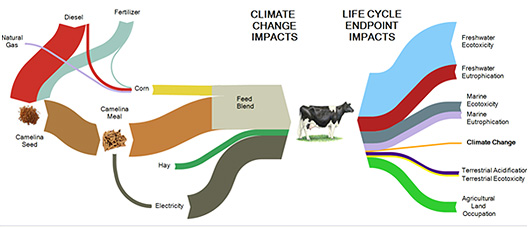
GasCube: Mobile Waste to Energy Concept for Remote US Air Force Base Deployments
The scope and objective of this program is to develop a modular process that converts organic waste from Air Force bases to energy and compost. The ‘Gas Cube’ concept is a deployable, rugged, self-contained system to convert organic base solid waste and wastewater biosolids into methane and compost, allowing the Air Force to better utilize mobile base organic wastes to produce useful energy and other products. This research is being accomplished by
Dr. Jim Stone and members of his research group (
http://jamesstonesdsmt.wix.com/stone) along with collaborators from Chemical and Biological Engineering Department and industry.
Source Water Implications Associated with the Current Black Hills Mountain Pine-Beetle Infestation
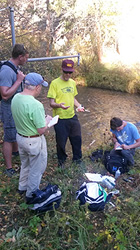 The focus of this research is to quantify the effects on source water hydrology and supply due to the current mountain pine beetle (MPB) outbreak within the Black Hills of South Dakota. Currently, 390,000 acres of Rocky Mountain ponderosa pine within Black Hills National
Forest (BHNF) has been impacted and is predicted to exponentially continue throughout the Black Hills of South Dakota and Wyoming, resulting in more than 1,000,000 acres of ponderosa pine die off. Without immediate implementation of expensive control measures (e.g.,
mechanical stand thinning, chemical treatments), the Black Hills will be more susceptible to expansive wildfires, loss of wildlife habitat and tourism revenue, and perhaps most importantly, potentially long term impairment of regional water resources. As land-surface cover changes,
MPB outbreak is suspected to result in significant changes to local and regional surface water and groundwater resources as hydrologic patterns are altered. These effects may necessitate long-term changes to water management as both the quantity and quality of local and regional
surface water and groundwater resource may be compromised. Recent studies for lodge pole pine MPB-impacted areas of Colorado, Wyoming, and British Columbia document dramatic changes with groundwater recharge zones and regional flow regimes, however there is much uncertainty how
widespread ponderosa pine die off may impact Black Hills regional source water resources.
Dr. Jim Stone's research group (
http://jamesstonesdsmt.wix.com/stone) in collaboration with USGS are investigating water quality changes for various MPB impacted watersheds within the Black Hills.
The focus of this research is to quantify the effects on source water hydrology and supply due to the current mountain pine beetle (MPB) outbreak within the Black Hills of South Dakota. Currently, 390,000 acres of Rocky Mountain ponderosa pine within Black Hills National
Forest (BHNF) has been impacted and is predicted to exponentially continue throughout the Black Hills of South Dakota and Wyoming, resulting in more than 1,000,000 acres of ponderosa pine die off. Without immediate implementation of expensive control measures (e.g.,
mechanical stand thinning, chemical treatments), the Black Hills will be more susceptible to expansive wildfires, loss of wildlife habitat and tourism revenue, and perhaps most importantly, potentially long term impairment of regional water resources. As land-surface cover changes,
MPB outbreak is suspected to result in significant changes to local and regional surface water and groundwater resources as hydrologic patterns are altered. These effects may necessitate long-term changes to water management as both the quantity and quality of local and regional
surface water and groundwater resource may be compromised. Recent studies for lodge pole pine MPB-impacted areas of Colorado, Wyoming, and British Columbia document dramatic changes with groundwater recharge zones and regional flow regimes, however there is much uncertainty how
widespread ponderosa pine die off may impact Black Hills regional source water resources.
Dr. Jim Stone's research group (
http://jamesstonesdsmt.wix.com/stone) in collaboration with USGS are investigating water quality changes for various MPB impacted watersheds within the Black Hills.
Water Resources Research in Mongolia
Mongolia is a vast contrast in watershed environments from the vast Gobi Desert region north to the glacial Altai Mountains. The climate is mostly arid to semi-arid with annual average precipitation on the order of 350 mm. Rapid growth in the mining industry, increasing domestic demands and development of irrigated agriculture is placing significant demands on available water resources. Due to the characteristics of the Mongolian climate, climate change is also a significant factor in water resources development and management. Through his 2012-13 Fulbright Scholarship
Dr. Kenner has developed collaborative research with Soninkhishig Nergui, Head of Biology, National University of Mongolia. The focus of their research is on developing environmental low flows for major rivers in the Selenge River basin which represents approximately 70% of the drainage area to Lake Baikal. The results of this work will provide critical information for water resources development in Mongolia.
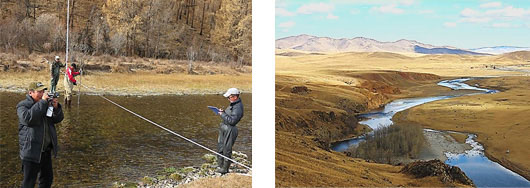
Additionally Dr. Kenner is working collaboratively with Oyuntungalaa at the Science and Technological School at Erdenet and the Erdenet Cooper Mine. Water management applications toward a water budget for the mining complex to minimize use of make-up water (from the Selenge River) to the mine is being conducted. With the rapid growth in demands and multiple project alternatives development and application of Integrated Water Resources Management through Shared Vision Planning is being developed and applied for the Orkhon River Basin.
Pine Beetle Impacts on Watershed Runoff
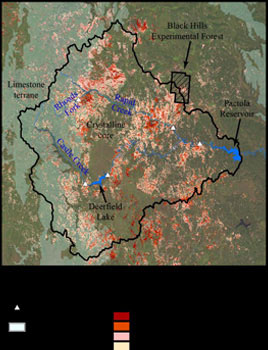 Ponderosa pine has a significant effect on the hydrologic budget of arid to semi-arid watersheds, with estimates of evapotranspiration accounting for up to 95 percent of precipitation. There is a need for studies of the hydrologic response of ponderosa pine forests, which are not a snow-dominated system, but are rather semi-arid settings where evapotranspiration potentially plays a greater role in the hydrologic budget. Current research to develop predictive models of springflow and streamflow that represent the hydrologic response of a forested watershed to pine beetle infestation is being conducted. The models will be developed for the Black Hills, with emphasis on the Rapid Creek watershed above Pactola Dam (Figures 1), which has four USGS streamflow gauges, one climate station, and two SNOTEL sites. The model of hydrologic response to pine beetle infestation will be adapted from the conceptual model for a sub-alpine forested watershed. Modeled response will be compared to responses documented in other Rocky Mountain watersheds. This conceptual model includes five stages of tree mortality that potentially span 10 years, during which trees change from infested with green-needles, dead with red-needles, gray with no needles, falling trees, and finally regeneration. Hydrologic responses include changes to water yield (fraction of precipitation that becomes runoff), peak flow, low flow and timing of flow events. We will also explore the potential for Landsat (particularly the new imagery from Landsat 8) to identify stages of tree mortality and validate the current mapping.
Ponderosa pine has a significant effect on the hydrologic budget of arid to semi-arid watersheds, with estimates of evapotranspiration accounting for up to 95 percent of precipitation. There is a need for studies of the hydrologic response of ponderosa pine forests, which are not a snow-dominated system, but are rather semi-arid settings where evapotranspiration potentially plays a greater role in the hydrologic budget. Current research to develop predictive models of springflow and streamflow that represent the hydrologic response of a forested watershed to pine beetle infestation is being conducted. The models will be developed for the Black Hills, with emphasis on the Rapid Creek watershed above Pactola Dam (Figures 1), which has four USGS streamflow gauges, one climate station, and two SNOTEL sites. The model of hydrologic response to pine beetle infestation will be adapted from the conceptual model for a sub-alpine forested watershed. Modeled response will be compared to responses documented in other Rocky Mountain watersheds. This conceptual model includes five stages of tree mortality that potentially span 10 years, during which trees change from infested with green-needles, dead with red-needles, gray with no needles, falling trees, and finally regeneration. Hydrologic responses include changes to water yield (fraction of precipitation that becomes runoff), peak flow, low flow and timing of flow events. We will also explore the potential for Landsat (particularly the new imagery from Landsat 8) to identify stages of tree mortality and validate the current mapping.